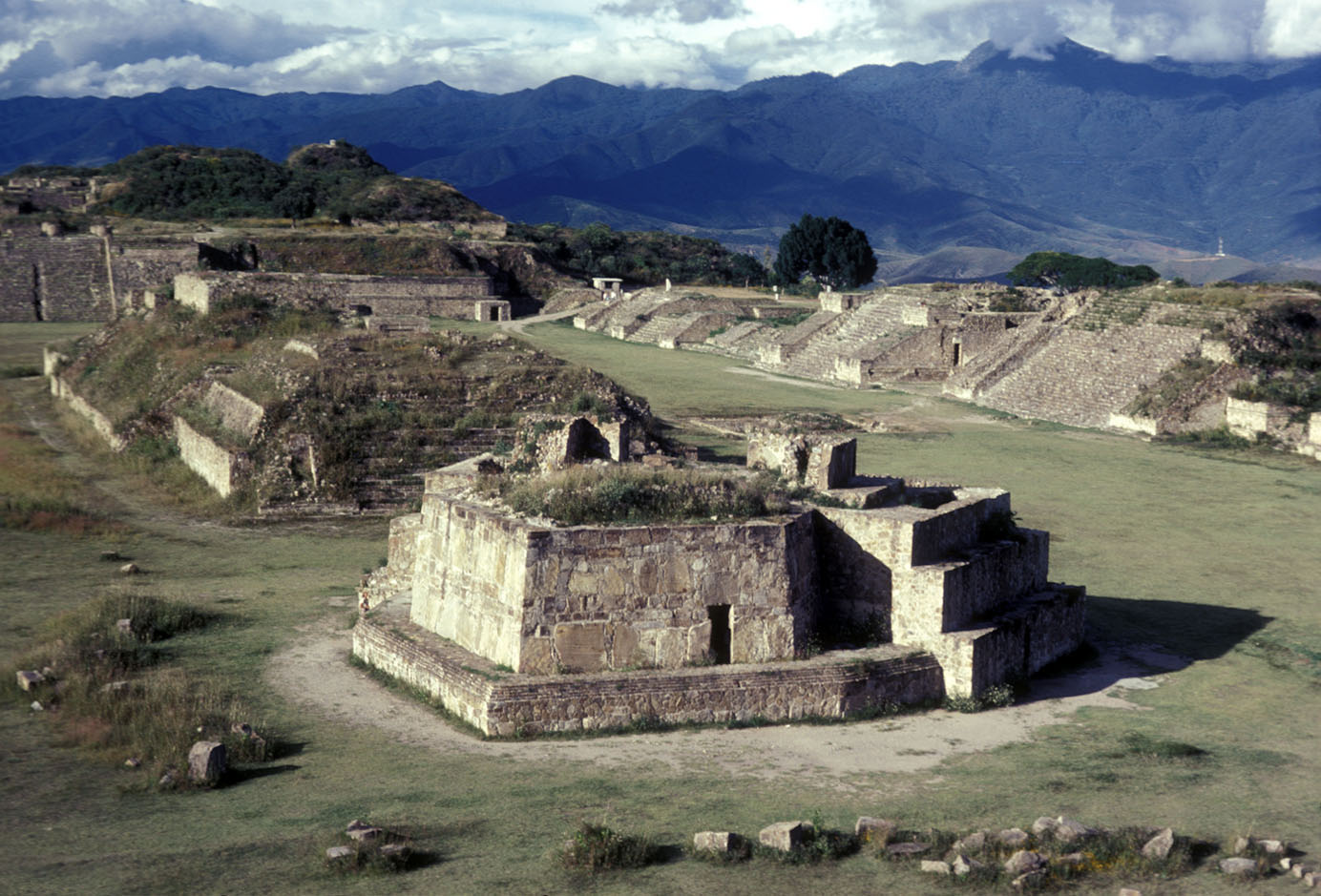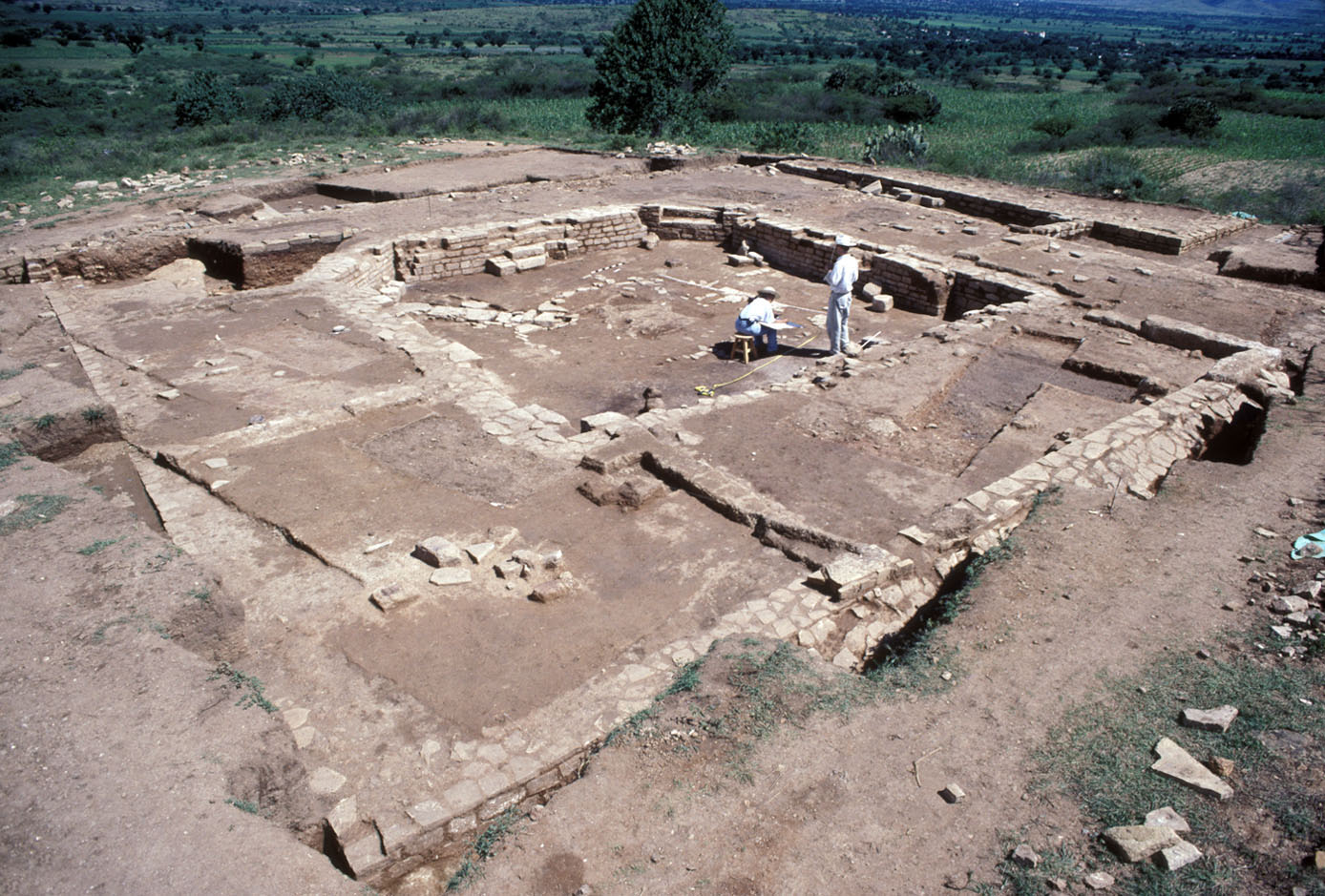News Release 10-060
New Research Finds Bureaucracy Linked to a Nation's Growth
A state's collective organizational structure, procedures and protocols develop hand-in-hand with "predatory" expansion

Buildings in Monte Albán with inscriptions depicting conquest.
April 16, 2010
This material is available primarily for archival purposes. Telephone numbers or other contact information may be out of date; please see current contact information at media contacts.
"Bureaucracy is the death of all sound work," said Albert Einstein, sharing a popular view about bureaucracy grinding progress to a halt.
But it now appears that the organizing functions of bureaucracy were essential to the progressive growth of the world's first states, and may have helped them conquer surrounding areas much earlier than originally thought. New research conducted in the Valley of Oaxaca near Monte Albán, a large pre-Columbian archaeological site in southern Mexico, also implies that the first bureaucratic systems may have a lasting influence on today's modern states.
The research by the American Museum of Natural History (AMNH), funded in part by the National Science Foundation (NSF) through its Social, Behavioral and Economic Sciences directorate, is published in this week's Proceedings of the National Academy of Sciences (PNAS).
"The earliest evidence of state organization is contemporaneous with the earliest evidence of long-distance territorial expansion," said lead researcher Charles Spencer, curator of Mexican and Central American Archaeology at the AMNH. "This pattern was consistent with the territorial-expansion model of primary state formation, which I have proposed in a number of publications over the years."
Spencer's territorial-expansion model argues that states arise through a mutual-causal process involving simultaneous territorial expansion and bureaucratization. Spencer's model breaks with previous ideas that suggest states rise through a protracted, step-by-step process--first the state forms, then an organizing bureaucracy takes hold, and sometime later, the state begins to expand into other regions in an "imperialistic" fashion, thus giving birth to an empire.
Archaeological research conducted by Spencer in an Oaxaca canyon some 50 miles north of Monte Albán suggests that the old distinction between state and empire probably is not useful.
In the Oaxaca Valley, Spencer found evidence of a royal palace and a multi-room temple dating to 300-100 B.C. Most Oaxaca archaeologists consider the royal palace to be evidence of a specialized ruling class and the multi-room temple to be evidence of a specialized priestly class.
Spencer notes that around 300 B.C., the first signs of state organization start to appear in the Oaxaca Valley where Monte Albán is situated. It also is the same time that the ancient Monte Albán state started conquering the surrounding regions.
Spencer suspects that all bureaucratic states--even modern ones--may be inherently predisposed, or "hard-wired," to engage in predatory expansion as a legacy of the original process of primary state formation.
The PNAS paper compares Spencer's work in Mesoamerica with archaeological data from five other states most anthropologists recognize as the only other locations of true primary state formation in history: Peru, Egypt, Mesopotamia, the Indus Valley and China. Primary states are first-generation states that evolved without contact with other pre-existing states. In each case, Spencer's territorial-expansion theory holds. But he says more research needs to be done at the other locales.
"This result may provide a cautionary lesson as we think about international relations in our contemporary world," said Spencer. "Since the bureaucratic state as a political form originally evolved through a process of predatory expansion, we should not be surprised if states continue to have predatory tendencies, regardless of their particular ideologies."
Spencer said his research results could be seen as reason to support development of international organizations such as the United Nations to serve as a check on the expansionistic tendencies of individual states. "But, the administration of those organizations is also likely to be bureaucratic, so we should be watchful for predatory behavior from them as well," he said.
-NSF-
-
The main plaza of Monte Albán.
Credit and Larger Version -
The residential portion of a royal palace in the Oaxaca Valley dating to 300-100 B.C.
Credit and Larger Version
Media Contacts
Bobbie Mixon, NSF, (703) 292-8485, email: bmixon@nsf.gov
Program Contacts
John E. Yellen, NSF, (703) 292-8759, email: jyellen@nsf.gov
Principal Investigators
Charles Spencer, American Museum of Natural History, (212) 769-5898, email: cspencer@amnh.org
The U.S. National Science Foundation propels the nation forward by advancing fundamental research in all fields of science and engineering. NSF supports research and people by providing facilities, instruments and funding to support their ingenuity and sustain the U.S. as a global leader in research and innovation. With a fiscal year 2023 budget of $9.5 billion, NSF funds reach all 50 states through grants to nearly 2,000 colleges, universities and institutions. Each year, NSF receives more than 40,000 competitive proposals and makes about 11,000 new awards. Those awards include support for cooperative research with industry, Arctic and Antarctic research and operations, and U.S. participation in international scientific efforts.
Connect with us online
NSF website: nsf.gov
NSF News: nsf.gov/news
For News Media: nsf.gov/news/newsroom
Statistics: nsf.gov/statistics/
Awards database: nsf.gov/awardsearch/
Follow us on social
Twitter: twitter.com/NSF
Facebook: facebook.com/US.NSF
Instagram: instagram.com/nsfgov




